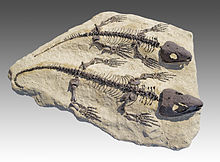Romeriidae
| Captorhinids Temporal range: Pennsylvanian - Lopingian 300–255 Ma |
|
|---|---|
 |
|
| Fossil Captorhinus specimens | |
| Scientific classification | |
| Kingdom: | Animalia |
| Phylum: | Chordata |
| Class: | Reptilia |
| Clade: | Eureptilia |
| Family: |
†Captorhinidae Case, 1911 |
| Type species | |
|
†Captorhinus aguti Cope, 1895 |
|
| Genera | |
|
See text |
|
| Synonyms | |
See text
Captorhinidae (also known as cotylosaurs) is one of the earliest and most basal reptile families, all members of which are extinct.
Captorhinids are a clade of small to very large lizard-like reptiles that date from the late Carboniferous through the Permian. Their skulls were much stronger than those of their relatives, the Protorothyrididae, and had teeth that were better able to deal with tough plant material. The postcranial skeleton is very similar to that of advanced reptiliomorph amphibians, so much in fact that the amphibian Seymouriamorpha and Diadectomorpha were thought to be reptiles and grouped together in "Cotylosauria" as the first reptiles in the early 20th century. Captorhinids have broad, robust skulls that are generally triangular in shape when seen in dorsal view. The premaxillae are characteristically downturned. Early, smaller forms possessed single rows of teeth, while larger, more derived forms such as Captorhinus and the herbivorous Moradisaurus which could reach an estimated snout-vent length of 2 meters (6.5 feet), possessed multiple rows of teeth.
Until recently, Concordia cunninghami was thought to be the basalmost known member of Captorhinidae. A novel phylogenic study of primitive reptile relationships by Muller & Reisz in 2006 recovered Thuringothyris as a sister taxon of the Captorhinidae. The same results were obtained in later phylogenic analyses.Concordia is still the earliest known captorhinid as all other captorhinid taxa are known only from Permian deposits.
...
Wikipedia
